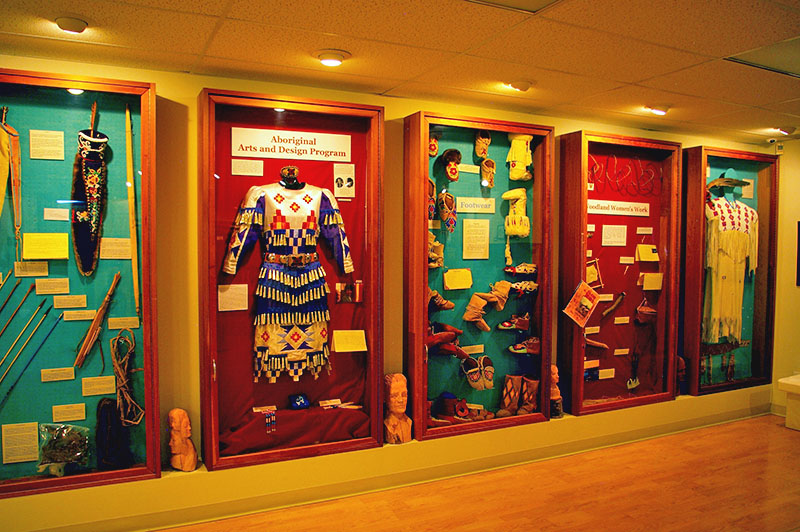
Description: Included in this category are museums that are primarily devoted to Aboriginal culture, from an Indigenous point of view. Many museums contain Indigenous material culture but are primarily devoted to white settler narratives. Much important scholarship in critical museum theory has been devoted to analysing the construction and transformation of anthropological museums and collections, including work by Ruth Phillips, Miriam Clavir, and James Clifford. In light of the recommendations of the Truth and Reconciliation Commission, this theme highlights the innovative ways in which museums produced, curated and managed by Aboriginal and Métis people grapple with and contest both the conventional practices of museums, and the standard narratives told about heritage in many of the small town and rural museums in Alberta.



Featured Museum:
Fort
Chipewyan Bicentennial Museum

Click the image for more photos of Fort Chipewyan Bicentennial Museum
Opened by the Fort Chipewyan Historical Society in 1991, the museum was built to commemorate Fort Chipewyan's 200th birthday in 1988. The exterior of the museum at Fort Chipewyan is an exact reconstruction of the Hudson’s Bay store built there in 1870. Fort Chipewyan is the oldest continuously inhabited settlement in the Province of Alberta, and it was an active fur trading centre during the eighteenth and nineteenth centuries, bringing diverse Indigenous, Inuit, and European peoples into conflict and cooperation. The museum's displays and exhibits depict Fort Chipewyan's past, with a growing collection of artifacts, many of them donated by local people. The museum also functions as an archives, reference library, and cultural centre, hosting classes and community events. It is much appreciated by the people of Fort Chipewyan and run by devoted workers, including its former curator Oliver Glanfield. In 1993, the small Fort Chipewyan Historical Society beat out larger organizations to win the Heritage Tourism Award from the Tourism Industry Association of Alberta (TIALTA). Cathy McGinnis, representing the society at the TIALTA event, said that until last year she was the only Native person in the organization. Two others have since joined and McGinnis hopes the recognition of the Society has received will spur more Aboriginal participation in the administration.

Other Aboriginal Museums:


Blackfoot
Crossing Historical Park

Click the image for more photos of Blackfoot Crossing Historical Park
A modern, spacious interpretive centre with a library, archives, and a conference centre, Blackfoot Crossing is located above the historic valley where Treaty 7 was signed in 1877. The museum was high enough to avoid flood damage in 2013 but its extensive trails throughout the valley were washed out. Several footbridges on the surrounding paths were destroyed, leaving the trails closed to tours. The museum itself however, uses a variety of storytelling methods to display, explain, and promote the cultures of the four Blackfoot nations. The collections, didactic texts, and videos are almost overwhelming in their detail and emotion, and can hardly be done justice with a single visit. Some exhibits are dedicated to promoting the Blackfoot language, both spoken and written. Throughout, a narrative of reclaimed cultural heritage is told, with one eye firmly on the future and another on the past. Blackfoot Crossing is a central part of the community and is easily accessed from the main road through Siksika Nation, just a few kilometres from Highway 1.
Native Cultural Arts Museum

Click the image for more photos of Native Cultural Arts Museum
The Native Cultural Arts Museum, established in 1976, is associated with Northern Lakes College in Grouard. The exhibition space showcases the cultures of the Woodland Cree and Métis peoples, past and present, and programming emphasizes the teaching of traditional craft skills such as quillwork. The displays, which include permanent and temporary exhibits, feature examples of art, music, hunting, regalia, clothing, and more. Although it is open year round, the summer programming is especially popular. The Grouard Historical Village, or Culture Camp, is a living history program in which costumed interpreters teach traditional skills such as raising a tipi, cooking bannock, and tanning hides. Children from schools as far as 300 kilometres away are bussed in for the event. The Museum also conducts interpretive tours of Grouard, outreach programming, and organizes travelling exhibits. Despite its modest size compared to a major interpretive centre like Blackfoot Crossing, the Native Cultural Arts Museum nevertheless manages to provide diverse and engaging programming.


 Resource Museumstop of page
Resource Museumstop of page












 Resource Museumstop of page
Resource Museumstop of page